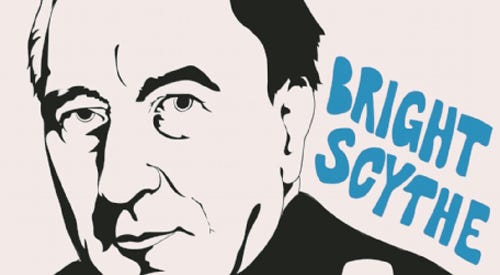Books & Culture
Prayers to the Emptiness: Bright Scythe by Tomas Tranströmer

by Zack Hatfield

How does one review Tomas Tranströmer? Many have tried, and done well, yet his poems evade analysis in their sheer attempt, and triumph, at conducting a certain shift of emotion in their reader, both seismic and molecular. If that sounds contradictory, that’s because it is — Tranströmer’s work is full of paradox in its themes, imagery and form.
Do not arrive to the poetry of Tomas Tranströmer soliciting answers. That is not to say you will leave empty-handed, but that Tranströmer’s work strays from the absolute. He is, first and foremost, a chronicler of the interstice, his poetry a patient crowbar between the thresholds we inhabit: night and day, asleep and awake, living and dying. They require no context but life itself. Bright Scythe, a collection of his work newly translated from the Swedish by Patty Crane, is a literary panorama with work from 1954 to 2004, and deftly traces the poet’s quiet interrogation with life’s phenomena.
In 2011, Tranströmer was awarded the Nobel Prize, specifically “because, through his condensed, translucent images, he gives us fresh access to reality.” And so I approached Bright Scythe expecting a kind of mirror or kind of lake, reflecting perhaps the many endlessnesses of Scandinavia’s darkest winters. What I did not expect was how Tranströmer defined “reality,” and how he gives us “access” not through detailed truths, but through his ability to translate the somnambulance and total strangeness of life into a better understanding of what it means, simply, to be.
Tranströmer’s poems are written in free verse, their stanzas averaging little over an inch in width in the beginning years. The five decades of output we’re given in Bright Scythe gives us insight to how his poetry and outlook changed over time, but it seems that Tranströmer’s plangent subject matter — the seasons, memory, dreams, art and oblivion — never changed with his form. Though the centerpiece of Bright Scythe is his epic saga “Baltics,” his shorter works find more urgency, often trading enjambment for terser sentences that end with periods on each line.
The poet, who suffered a life-changing stroke in 1990 and died earlier this year, populates his poems with curious metaphors. Consider “April and Silence,” from The Sorrow Gondola (which was written in 1996 and is translated in its entirety here):
Spring lies forsaken.
The velvet-dark ditch
crawls by my side
without reflections.
The only thing that shines
are yellow flowers.
I am cradled in my shadow
like a fiddle
in its black case.
The only thing I want to say
glimmers out of reach
like the silver
at the pawnbroker’s.
The unexpectedness of these lines, the “shadow / like a fiddle / in its black case” and the pawnbroker’s silver, are representational of Tranströmer’s ability to meld imagery and convey truth through ambiguous and idiosyncratic comparison. In other poems a “moment darkens / and remains like an axe-scar on a trunk.” A “clear sky has leaned against the wall” and it is like “a prayer to the emptiness.” “Moths settle on the windowpane: / small pale telegrams from the world.” Dark pavilions “glow like TV screens.” This beautiful awkwardness abounds in the collection, rewarding patience with glitches in expectation.
Crane, whose work presents the original jagged Swedish on the opposite page of her translations, stays close to the source. She measures with finesse each syllable and simile much like the three Roberts that have approached the Swedish poet’s work before — Robert Haas, Robert Bly and Robin Robertson, though her balanced and less strictly literal approach is closest to Robertson’s. This decision to not completely remake Tranströmer’s poems, to preserve the poet’s distinct timbre, is admirable but also necessary; after reading a few interpretations of Tranströmer’s poems, one feels not that the translators’ work reads too much like translated work, but that Tranströmer’s verse itself reads as though translated from some distant text, a message given, perhaps, to only him, his prayer to the emptiness. Therein lies the stark sublimation. Interestingly, Crane was able to spend some time with Tranströmer and his wife in the poet’s later years, time that presumably imparted a more cultural and personal element than prior interpretations were able to achieve.
It is no coincidence that prayer is found frequently in his poems. Like his work, they too rely on a kind of contradiction — a secret confession. They may be prayers to emptiness, but, as this book insists, they must not go unanswered.









